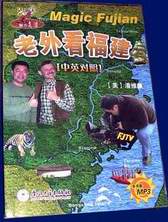![]() Click
to
Access
Click
to
Access
OUTSIDE China
![]() Click
to Access
Click
to Access
INSIDE
China ![]()
![]()
![]() Xiamen
Xiamen
![]() Gulangyu
Gulangyu
![]() Jimei
Jimei
![]() Tong'an
Tong'an
![]() Jinmen
Jinmen
![]() Zhangzhou
Zhangzhou
![]() Quanzhou
Quanzhou
![]() Wuyi
Wuyi
![]() Fuzhou
new!
Fuzhou
new!
![]() #1Fujian
Sites!
#1Fujian
Sites!
![]() Fujian
Foto Album
Fujian
Foto Album
![]() Books
on Fujian
Books
on Fujian
![]() Readers'Letters
Readers'Letters
![]() Ningde
Ningde
![]() Zhouning
Zhouning
![]() Longyan
Longyan
![]() Sanming
Sanming
![]() Putian
Putian
![]() Bridges
Bridges
![]() Travel
Info,
Travel
Info,
![]() Hakka
Roundhouses
Hakka
Roundhouses
![]() Travel
Agents
Travel
Agents
![]() Mosques
Mosques![]()
![]() Temples
Temples![]()
![]()
![]() Amoy
People!
Amoy
People! ![]()
![]() Darwin
Driving
Darwin
Driving ![]()
![]() Amoy
Tigers
Amoy
Tigers
![]() Chinese
Inventions
Chinese
Inventions
![]() Tibet
in 80 Days!
Tibet
in 80 Days!![]()
![]() Dethroned!
Dethroned!
![]()
![]() Misc.Writings
Misc.Writings
![]() Latest
News
Latest
News
![]() Lord
of Opium
Lord
of Opium
![]() Back
to Main Page
Back
to Main Page
![]() Order
Books
Order
Books![]() Xiamenguide
Forum
Xiamenguide
Forum 

![]()
Fuzhou,
Ancient Capital of Fukien
City of Merchants, Adventurers, Scholars
Adapted from "Fujian Adventure",
Magic Fujian, etc.
Fuzhou Links ![]() History
History
![]() Haunted
Nantai Island (Foreign Devils & Chinese Ghosts)
Haunted
Nantai Island (Foreign Devils & Chinese Ghosts)
![]() Pagoda
Anchorage
Pagoda
Anchorage
![]() Downtown
Downtown
![]() Cuisine
Cuisine
![]() Shopping
Shopping
![]() Secret
Yongtai
Secret
Yongtai ![]() Mosque
Mosque

![]() Iron
Buddha
Iron
Buddha ![]() Ming
Dynasty Wall
Ming
Dynasty Wall
Heart of Fuzhou: East Gate CrossRoads (Dongjie
Kou) is still Fuzhou¡¯s hot spot, day or night. Here you¡¯ll find a dozen
key tourist sites and scores of shops and restaurants all within walking
distance. But how to find it? It¡¯s where East Street (Dong Lu) crosses
August 17th St. Simple enough, but it can get confusing because Bayiqi
Lu becomes Guping Lu above Dongjie Kou, and west of Dongjie Kou, Dong
Lu becomes Yangqiao Lu.
I suspect Fuzhou¡¯s shifty street names are a deliberate revenge against
us Laowai for 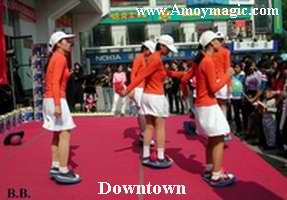 Opium
Era indignities visited upon their forebears.
Opium
Era indignities visited upon their forebears.
The East Gate area was mobbed by
shoppers, vendors, and tourists. Salesmen demonstrated late breaking products,
Honda motorcycles, and handed out free samples of soy milk and medicines
that guaranteed children to grow up healthy and smart. A dozen bouncy
teens in cheerleader costumes bounced up and down on pogo balls. ¡°A bargain
at only 60 Yuan each!¡± (The pogo balls, not the girls). And of course¡ªa
battalion of beggars sporting ingenious incapacitations and devilish deformities.
I was also struck by the preponderance of bright yellow and red bikes
(though they were nothing compared with Quanzhou¡¯s sherbert bikes). The
bikes are probably a fad--I know these things go in cycles.
 3
Wards, 7 Lanes (San Fang QiXiang) A block west of August
17th St. lies the ancient 3 Wards, 7 Streets area. Built over 700 years
ago, in the Song Dynasty, this area had 104 streets, though most of the
lanes remaining today are from the Qing or Ming Dynasties, which is yesterday
by Chinese standards.
3
Wards, 7 Lanes (San Fang QiXiang) A block west of August
17th St. lies the ancient 3 Wards, 7 Streets area. Built over 700 years
ago, in the Song Dynasty, this area had 104 streets, though most of the
lanes remaining today are from the Qing or Ming Dynasties, which is yesterday
by Chinese standards.
This area really bustled a century ago, especially where Guanglufang and
Jipi Road cross. Jipi Rd was originally called Jibi Rd., (¡®hurried escape,¡¯
because an evil man lurked there).
3 Wards and 7 Lanes is chockfull
of history, but without someone to explain the significance of buildings
behind the nondescript gates, I¡¯d have walked past the entire lot without
a second glance. Fortunately, I ran into an official guiding a Beijing
journalist. He reluctantly allowed the scruffy Laowai to tag along and
listen, but he seemed a little disconcerted when I whispered notes into
my micro recorder. ¡°I¡¯m writing a book,¡± I said, but he didn¡¯t seem convinced.
Maybe he thought I was 006?
Each nondescript gate hid a maze of courtyards, gardens, and rooms. Most
houses badly need renovating, though a few had beautiful murals and carvings
that had escaped the ravages of the Cultural Revolution. One fellow looked
up from washing his clothes and complained to the official,
¡°You¡¯d have more to show off to these foreigners if you¡¯d help us preserve
the places!¡±
Beauties¡¯ Bench Courtyards still
had the wooden benches (???, meirenkao) where beautiful girls with  bound
feet spent their days on display. These sprawling homes probably used
up half a forest on their ornate, time-stained wooden columns, beams,
latticework, and doors, which contrasted nicely with the gray tiles and
white walls. The floors were built of stone to withstand the heavy annual
rains of South China.
bound
feet spent their days on display. These sprawling homes probably used
up half a forest on their ornate, time-stained wooden columns, beams,
latticework, and doors, which contrasted nicely with the gray tiles and
white walls. The floors were built of stone to withstand the heavy annual
rains of South China.
Many of the Opium Era hero Linzexu¡¯s family
lived in this area. His mother¡¯s home was at Wenrufang #17. One of her
neighbors was Cheng Cheng Qiu, the Last Qing Dynasty Emperor¡¯s teacher.
He borrowed heavily from the Beijing palace¡¯s architecture with his high
ceilings and intricate recessed wooden carvings. The gray beams, which
on holidays sport festive lanterns, had orange bats because ¡°bat¡± in Chinese
sounds like ¡°bianfu¡± (to become prosperous).
Chinese also go batty over bamboo¡ªor at least used to...
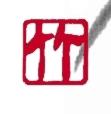 Bamboo¡ª
Poetic and Practical People still flock to the 3 Streets
and 7 Lanes area at Chinese New Year to buy lanterns and other ornamental
objects, or to buy products from one of China¡¯s endangered species: the
bamboo craftsman. It¡¯s a pity bamboo craftsman are vanishing, because
bamboo helped shape Chinese culture for millennia. Please
click here for Bamboo--Poetic & Practical (How Chinese invented
everything under the sun, in part because of bamboo).
Bamboo¡ª
Poetic and Practical People still flock to the 3 Streets
and 7 Lanes area at Chinese New Year to buy lanterns and other ornamental
objects, or to buy products from one of China¡¯s endangered species: the
bamboo craftsman. It¡¯s a pity bamboo craftsman are vanishing, because
bamboo helped shape Chinese culture for millennia. Please
click here for Bamboo--Poetic & Practical (How Chinese invented
everything under the sun, in part because of bamboo).
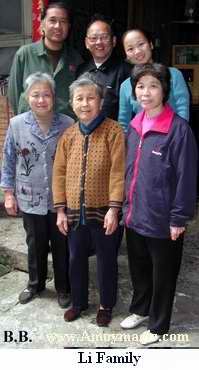
 The
Li Family House (Aomen Rd. # 60)
The
Li Family House (Aomen Rd. # 60)
Just across the street from the bamboo shop, beside the Linzexu Memorial
(which was being renovating), is a marvelous old building that looks rather
Western in architecture, with its wooden balconies and windows. It has
been home to six generations of the Li family, which made their fortune
in the lumber business (chairman of the board?).
They warmly welcomed me and led me inside for tea and a tour of the rambling
two-story wooden house, which is so unique even MTV used it to film a
special. They allowed me to take photos to my hearts content, and even
posed for a few. It may be one of the last photos of this extended family
in one place, because many of the younger generation are moving to greener
pastures across town or in other cities.
 Back
street vendors sell fresh fruit, cheap plastic alarm clocks,
porcelain figurines, and linen and clothing. One empty lot had a movie
screen set up in front of a red draped table loaded with incense and offerings.
A couple of dozen people squatted in the dark watching a grainy copy of
an action movie. I didn¡¯t know if it was a wake or a religious service
for Jackie Chan worshippers.
Back
street vendors sell fresh fruit, cheap plastic alarm clocks,
porcelain figurines, and linen and clothing. One empty lot had a movie
screen set up in front of a red draped table loaded with incense and offerings.
A couple of dozen people squatted in the dark watching a grainy copy of
an action movie. I didn¡¯t know if it was a wake or a religious service
for Jackie Chan worshippers.
A grandpa grinned at me. ¡°Join us!¡± As I watched Jackie punch, kick, and
run, the grandpa said, ¡°You probably don¡¯t have movies like this in America,
do you?¡±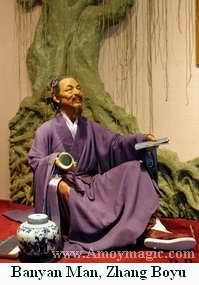
¡°Not yet,¡± I said, ¡°but we¡¯re getting there. Puppets and fireworks, too.¡±
Banyan City Fuzhou is pleasant
to stroll even in the heat of summer, thanks to the banyans that have
long shaded the ancient streets. Marco Polo called Fuzhou the ¡°City of
Banyans.¡±
About 1,000 years ago, Zhang Bo Yu planted two banyan trees in front of
the government office, and encouraged others to do the same. In addition
to being a welcome shelter from the summer sun, banyans are called the
¡°Fengshui Tree¡± because they supposedly only grow where the fengshui is
good.
Fuzhou's QingJing Mosque (Click
Here for how to find the mosque, it's history, and the rare stone
stele claiming Mohammed sent two of his disciples to Fujian).
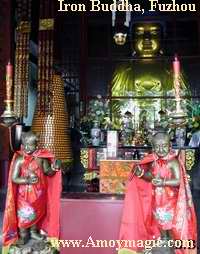 Kaiyuan
Temple has three claims to fame. One, the Japanese revere
Kaiyuan because Kukai, the founder of Japanese Buddhism, stayed here awhile
before heading north in search of either enlightenment or longer lasting
candles. Two, Kaiyuan has the largest cast iron Buddha in China. And three,
the place is famous for its Fujian Buddhist Association Clinic, where
Buddhist masters have long cured folks of everything from cancer to colic.
One pilgrim complained to me that the young monks aren¡¯t so good at it,
and are more concerned with mobile phones than mantras. Still, the clinic
does a steady business, though it has moved to #184-1 on the Second Ring
Road.
Kaiyuan
Temple has three claims to fame. One, the Japanese revere
Kaiyuan because Kukai, the founder of Japanese Buddhism, stayed here awhile
before heading north in search of either enlightenment or longer lasting
candles. Two, Kaiyuan has the largest cast iron Buddha in China. And three,
the place is famous for its Fujian Buddhist Association Clinic, where
Buddhist masters have long cured folks of everything from cancer to colic.
One pilgrim complained to me that the young monks aren¡¯t so good at it,
and are more concerned with mobile phones than mantras. Still, the clinic
does a steady business, though it has moved to #184-1 on the Second Ring
Road.
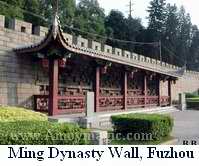
Fuzhou's Ming Dynasty Wall I was
excited to learn Fuzhou had a remnant of the original Ming Dynasty wall,
and searched for it for hours. But it turned out to be a very small remnant,
about the size of a carpet remnant after redoing the bathroom. The wall
is behind the Great Helmsman statue on Gutian Road, in front of Yushan
Mountain and the White Pagoda and across from KFC. Most of it has been
so well reconstructed it looks like Disney¡¯s interpretation of the Great
Wall, but a small 20-meter stretch of the original 1371 wall remains.
Once I got over the shock of how little remains, I realized it does give
one a sense of the ancient city¡¯s former grandeur, and I¡¯ve since visited
the fragment of wall several times.

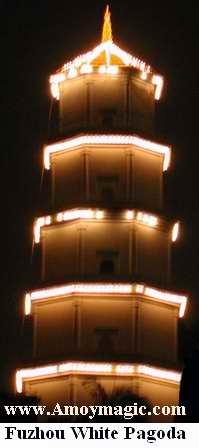 Yushan Hill, the City¡¯s Center, is a nice treat is an
early morning. After a hike to the top I enjoy listening to retirees who
greet each day playing traditional instruments and singing Chinese opera.
Yushan Hill, the City¡¯s Center, is a nice treat is an
early morning. After a hike to the top I enjoy listening to retirees who
greet each day playing traditional instruments and singing Chinese opera.
The seven story, 41m high White Pagoda on Yushan Hill
was built in 904 A.D., and is a beautiful photo spot, day or night. On
a clear day, one can supposedly see th sea from its top.
Legend has it that during the Han Dynasty (206 B.C.-A.D.220), the He brothers
tried to make immortality pills on Yushan Hill, so it is also called Nine
Immortal Hills¡ªeven though it doesn¡¯t appear the He brothers pills did
the trick. Yet even today, hopefuls visit the hilltop¡¯s Longevity Temple,
Taoist Temple of Nine Immortals, the Temple of Lord, and Dashi Hall.
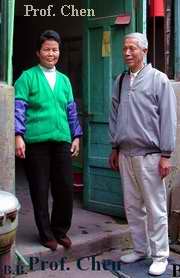 Clay
People Fuzhou Professor Chen De Ren, a noted author and
historian, led me to a nondescript house on a
Clay
People Fuzhou Professor Chen De Ren, a noted author and
historian, led me to a nondescript house on a  small
street. Within was a cultural treasure that even many Fuzhou folk are
unaware of ¡ªFuzhou Clay People (niren).
small
street. Within was a cultural treasure that even many Fuzhou folk are
unaware of ¡ªFuzhou Clay People (niren).
Professor Chen explained that during the Ming Dynasty, each time Fuzhou
folk bested the Japanese invaders, they piled their treasured possessions
in a pyramid that reached to the rafters. It was a way of showing thanks
that their belongings had not fallen into the pirates¡¯ hands.
Poorer people with few possessions, and
children, stacked cheap clay figurines. One year, during the 11th Lunar
month, General Qing Qing Guang (of sesame bread fame) beat the Japanese
and the clay people were pile high. This became a tradition until Red
Guards in the 1950s destroyed the figures.
The recent discovery of three molds rekindled an interest in the ancient
custom, and I visited the Fuzhou family that has taken it upon themselves
to restore dozens of the ancient molds. In 2001, they stacked the Clay
People for the first time in decades.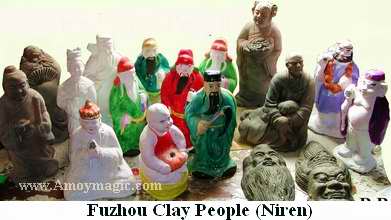 Unfortunately, when I visited they had just sold most of their stock to
a large hotel for an exhibition¡ªbut they assured me more are on the way.
Unfortunately, when I visited they had just sold most of their stock to
a large hotel for an exhibition¡ªbut they assured me more are on the way.
Fuzhou
City Museum opened in January 1999. English-speaking guides
give excellent tours and overviews of Fujian¡¯s history.
The museum had a statue of the great philosopher Zhuxi, whom I learned
some blame for footbinding. Zhuxi advocated a combination of Confucianism
and Taoism, and San Cong Ci De¡ªor Three Obediences and Four Moralities.
Obey husbands, obey fathers, and obey the emperor. (Obeying the wife goes
without saying).
 A
painting showed Chinese on horseback playing a game with a stick and ball,
so evidently polo was made in China as well¡ªor introduced by Marco Polo.
A
painting showed Chinese on horseback playing a game with a stick and ball,
so evidently polo was made in China as well¡ªor introduced by Marco Polo.
The museum¡¯s most macabre exhibit is the pair of male and female mummies
unearthed in August 1986 in Chayuan village. Buried somewhere around AD
1235, the corpses were so well preserved that their joints were still
nimble, and their clothes retained their bright colors. The female mummy¡¯s
twisted feet showed all too graphically the torture of foot binding.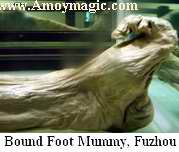
In America we say that when you die, you can¡¯t take it with you¡ªbut these
two sure did. Mummy and daddy were buried with lacquerware, silverware,
and several hundred pieces of silk, cotton, and linen.
I said to a Chinese, ¡°This is like The Mummy Returns!¡±
He said, ¡°Egyptian mummies have nothing on ours. Ours are intact, and
don¡¯t need us to reinstall their internal organs before conquering the
world!¡± Then he wailed, ¡°We¡¯re doomed!¡± I laughed¡ªbut the others glared
at us as if we were disrespectful of the desiccated dead.
 Riverside
Park A century ago, most wealthy Laowai and Laonei whiled
away hot summer days cruising up and down the more peaceful stretches
of the Min River on houseboats, and having picnics within the shady bamboo
forests. In 1923, Brand described the idyllic scenery:
Riverside
Park A century ago, most wealthy Laowai and Laonei whiled
away hot summer days cruising up and down the more peaceful stretches
of the Min River on houseboats, and having picnics within the shady bamboo
forests. In 1923, Brand described the idyllic scenery:
¡°Crossing on stepping stones one came out on what reminded one very much
of English scenery. Then ascending the hill one came to the glorious Bamboo
Groves, and how romantic it was to walk through these groups of feathery
bamboos, occasionally coming to an opening and gazing upon a scene of
perfect beauty¡ hills towering above one another in the distance, with
the stream running through the valley below, while here and there a water-wheel
added a little variety to it all.¡±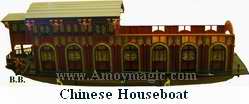
I haven¡¯t seen any houseboats lately, but thousands of Chinese from all
walks of life now enjoy strolling along the riverside park, enjoying the
fountains, ponds, and statues, or watching the sampans and barges cruise
by.
Hotheads & Hot Springs Perhaps
Fuzhou¡¯s fiery folk are such hotheads because of the many hot springs!
Fujian has hot springs everywhere (Changting, Anxi, Zhangzhou), but Fuzhou
is one of China¡¯s three largest hot springs regions, with prodigious amounts
of pure mineral water boiling up right in the middle of the city. Many
Fuzhou hotels tap right into the springs, offering mineral baths in the
room. You can¡¯t get any more convenient than that (though it lacks a certain
ambience when the mineral waters arrive by way of a stainless steel faucet).

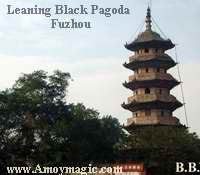
Pagoda
Anchorage (Mawei) Click Here for the historic Pagoda Anchorage,
China Pagoda, the Sino-French War, Majiang Memorial Hall, etc.
Drum Hill To the east of Fuzhou,
on the northern bank of the Min River and up the road from the statue
of Yan Fu ??the great philosopher and translator, is Yonggyuan Temple,
considered Fujian¡¯s most important temple. The 3,350 meter hill is named
after the huge, flat drum-like rock on the peak.
Yongquan
Temple, built halfway up the mountain in 908, has been
renovated so often that the 25 halls are now primarily Ming and Qing architecture.
The temple¡¯s claims to fame include a white jade sleeping Buddha (the
patron saint of siestas?), and 27,900 volumes of rare Buddhist scriptures,
including sutras written in human blood. In its prime the temple had 1,500
monks, and the kitchen still has four giant 1,000-year-old pots, one of
which is large enough that is supposedly feeds 1,000 monks at a shot.
The forested slopes of Drum Hill are cool even in summer, and perfect
for strolls along the well-maintained paths that crisscross every hill
in the country. And over the crest of the mountain lies the summer resort
frequented by foreigners and wealthy Chinese earlier in the century. I¡¯ve
read many stories of foreigners who passed the sultry summers on the mountain
in their cottages. They played tennis, swam in the river, held theatrical
performances, hunted the tigers that once prowled all of Fujian, and replaced
roofs blown off by blustering typhoons.
Nowadays, most of the old cottages have been torn down and the mountain
has become a summer resort for government and business leaders, with a
broad concrete highway reaching to the very peak.
FUZHOU LINKS
![]() Fuzhou
History (birthplace of Chinese Maritime Industry)
Fuzhou
History (birthplace of Chinese Maritime Industry)
![]() Pagoda
Island (famous "China
Pagoda," Sino-French Battle, etc.)
Pagoda
Island (famous "China
Pagoda," Sino-French Battle, etc.)
![]() Foochow's
Haunted Nantai Island Tour (Includes old Consulates, Rotary
Club, haunted churches...)
Foochow's
Haunted Nantai Island Tour (Includes old Consulates, Rotary
Club, haunted churches...)
![]() Heart
of Fuzhou: 3 Wards & 7 Streets, Li Family House, Banyan City,
Yushan Hill and White Pagoda, Clay People, etc.
Heart
of Fuzhou: 3 Wards & 7 Streets, Li Family House, Banyan City,
Yushan Hill and White Pagoda, Clay People, etc.
![]() Qingjing
Mosque
Qingjing
Mosque
![]() Secret
Valley of Yongtai (Fujian's Best Kept Secret)
Secret
Valley of Yongtai (Fujian's Best Kept Secret)
![]() Fuzhou
Cuisine (Buddha Jumps the Wall Soup, Pounded Pork, Fish Balls)
Fuzhou
Cuisine (Buddha Jumps the Wall Soup, Pounded Pork, Fish Balls)
![]() Fuzhou
Shopping
Fuzhou
Shopping
Note: Fuzhou
was also spelled Foochow, Fuh-chau, Fuhchau, etc.
![]() Favorite
Fujian Sites
Favorite
Fujian Sites ![]() Fujian
Foto Album
Fujian
Foto Album ![]() Xiamen
Xiamen
![]() Gulangyu
Gulangyu
![]() Fujian
Guides
Fujian
Guides ![]() Quanzhou
Quanzhou
![]() Zhangzhou
Zhangzhou
![]() Longyan
Longyan
![]() Wuyi
Mtn
Wuyi
Mtn ![]() Ningde
Ningde
![]() Putian
Putian
![]() Sanming
Sanming
![]() Zhouning
Zhouning
![]() Taimu
Mtn.
Taimu
Mtn. ![]() Roundhouses
Roundhouses
![]() Bridges
Bridges
![]() Jiangxi
Jiangxi
![]() Guilin
Guilin
![]() Order
Books
Order
Books![]() Readers'
Letters
Travelogues
by Scott Ballantyne
Readers'
Letters
Travelogues
by Scott Ballantyne
Last Updated: May 2007
![]()
![]()
![]() FAQs
Questions?
FAQs
Questions?
![]() Real
Estate
Real
Estate
![]() Shopping
Shopping
![]() Maps
Maps
![]() Trains
Trains
![]() Busses
Busses
![]() Hotels
Hotels
![]() News
(CT)
News
(CT)
![]() Medical
& Dental
Medical
& Dental
![]() YMCA
Volunteer!
YMCA
Volunteer! ![]()
![]() XICF
Fellowship
XICF
Fellowship
![]() Churches
Churches
![]()
![]() Expat
Groups
Expat
Groups
![]() Maids
Maids
![]() Phone
#s
Phone
#s
![]()
![]() Xiamen
University
Xiamen
University
![]() XIS(Int'l
School)
XIS(Int'l
School)
![]() Study
Mandarin
Study
Mandarin
![]() CSP(China
Studies)
CSP(China
Studies)
![]() Library
Library
![]() Museums
Museums
![]() History
History
![]()
![]() Restaurants
Restaurants
![]() Asian
Asian
![]() Veggie
Veggie
![]() Junk
Food
Junk
Food
![]() Chinese
Chinese
![]() Italian
Italian
![]() International
International![]()
![]() Visas
4 aliens
Visas
4 aliens
![]()
![]() Massage!
Massage!
![]() Beaches
Beaches
![]() Fly
Kites
Fly
Kites
![]() Sports
Sports
![]() Boardwalk
Boardwalk
![]() Parks
Parks
![]() Pets
Pets
![]() Birdwatching
Birdwatching
![]() Kung
Fu
Kung
Fu ![]() Hiking
Hiking
![]() Music
Events
Music
Events
![]() Festival&Culture
Festival&Culture
![]() Humor&
Humor&![]() Fun
Fotos
Fun
Fotos![]()
![]()
![]() Doing
Business
Doing
Business
![]() Jobs!(teach/work)
Jobs!(teach/work)
![]() Hire
Workers
Hire
Workers
![]() Foreign
Companies
Foreign
Companies
![]() CIFIT
(Trade Fair)
CIFIT
(Trade Fair)
![]() MTS(Translation)
MTS(Translation)
![]()
Back to Top![]()





